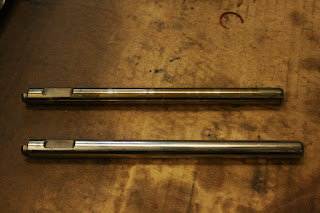One of the added benefits of this engine is the fact, that I rode the snot out of it in the last decade. Claiming to know its ins and outs might, as such, be a bit of an understatement. To be fair it also worked quite amicably. Pretty much the only thing I've never managed to sort out in the past was the fact that it was very notchy to shift, I measured the endplay of all the shafts about 5 or 6 years ago and given the fact that it is the stock gearbox and everything was set up by the book, I expected to find a bent selector fork. I was looking in the right direction, but it turns out, that in only 37 years old oil and some microscopic scratches had made the selector shaft very sticky.
This meant getting a tool out, most people don't even know, I own.
Top is a very good stock part and below the polished original selector shaft.
After some oiling of all the gears and a careful testrun of the gearbox (I've had some bad experiences in the past), it was time to clean the other side of the engine cases and then put them back together.
Call me old-fashioned, but I've built all my engines with red RTV and the same German brand has released the same sealant in black last year and yet still, I wouldn't feel comfortable to use it. Also, thin lines of sealant go a long way and are much better than thick gobs.
Cleaning parts is (I think) nobody's favourite, but polished combustion chambers do have their moments in this respect. From crusty bits to almost done in less than 10 minutes (for both heads). There was still some more to do but, that was literally after going over the head once with a rotating nylon brush.
An interesting find was to be made on the front cylinder. I had heard some detonation, which I suspect was down to a combination of: somewhat optimistic ignition advance, lean mixture and oil/carbon deposits on the piston tops in connection with a very large distance to the squish-area.
As the rear cylinder was fine, I started with a quick hone-job just to give the new rings something to bite into and then checked the ring-endgaps to determine, whether they came gapped correctly from the factory.
Fresh set of rings installed...
... and plenty of oil, probably my only genuine sin, I am guilty of, every single time, when building an engine. But I admit, even after doing more than my fine share, I am afraid of seizures.
As the other piston needed some replacement, I had to call in some favours to get a good piston in the right size, so would be a good fit to the cylinder. (Well aware, that normally you do this the other way round...)
Of course at this point the bottom end had more or less been completed, so a few precautionary steps had to be taken, to prevent the clip from falling into the engine.
The gudgeon pin was dimensionally ok and only needed a bit of a cleanup and polish.
Looking good again – after taking some measurements on both cylinders, I decided to try my own engine without a base gasket as the clearance is well big enough, yet it would get the piston close enough to the head to make the squish work a lot more efficient.
And lastly there was the question on the condition of cams and rockers, as they tend to suffer from oil-starvation. In short perfect. The roller cam conversion and the modified union bolt both raise the oil-level and the amount of oil-pumped into the head and in short... perfect.
A bit of moly-grease does wonders as an assembly lube and protects cams and rockers during those first revolutions until the first fresh oil reaches the head.
And that's where we are now. The engine is basically assembled.
By now (after those pictures were taken) both cams are timed, but the sprocket bolts require a drop of
loctite and the clutch cover has to go on and then it's gonna be
test-run o'clock in my everyday TR1-chassis, while I do the affore mentioned modifications to my own engine. Also I am somewhat itching to try out a few things with the single left-over piston ...























No comments:
Post a Comment